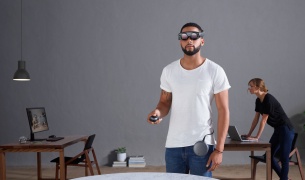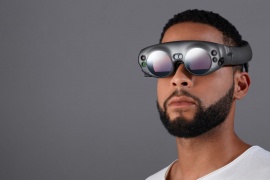Magic Leap One

| Magic Leap One | |
|---|---|
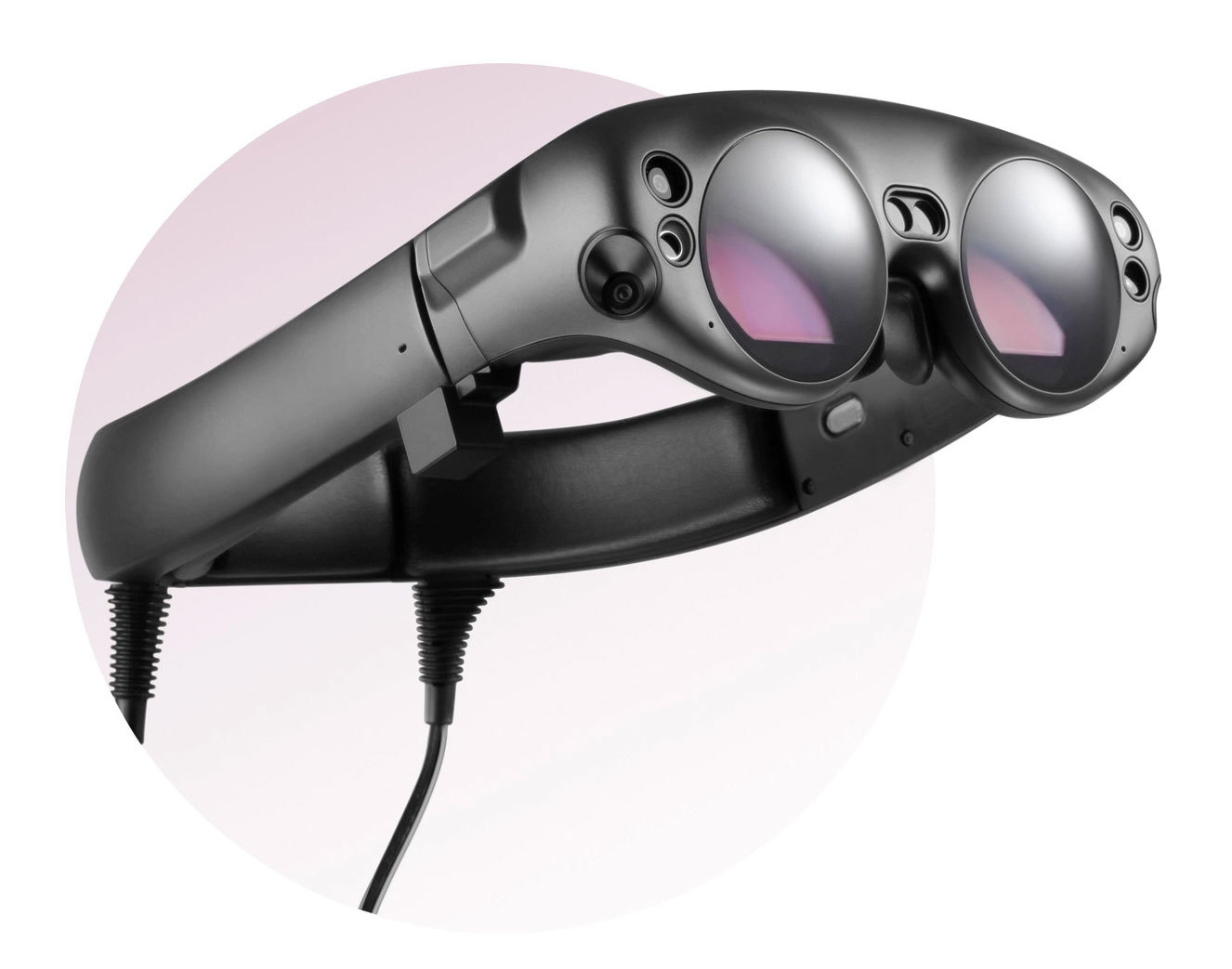
| |
| Basic Info | |
| VR/AR | Augmented Reality/Mixed Reality |
| Type | Head-mounted display |
| Subtype | Standalone AR |
| Platform | Magic Leap |
| Creator | Rony Abovitz |
| Developer | Magic Leap |
| Manufacturer | Magic Leap |
| Announcement Date | December 20, 2017 |
| Release Date | August 8, 2018 |
| Price | $2,295 USD |
| Website | https://www.magicleap.com/ |
| Versions | Magic Leap One: Creator Edition |
| Requires | None (standalone device) |
| Predecessor | None |
| Successor | Magic Leap 2 |
| System | |
| Operating System | Proprietary OS based on Linux |
| Chipset | NVIDIA Parker SOC |
| CPU | NVIDIA Parker SOC; 2 Denver 2.0 64-bit cores + 4 ARM Cortex A57 64-bit cores (2 A57's and 1 Denver accessible to applications) |
| GPU | NVIDIA Pascal, 256 CUDA cores |
| Storage | |
| Storage | 128 GB (95 GB available to user) |
| Memory | 8 GB RAM |
| SD Card Slot | No |
| Display | |
| Display | Waveguide-based lightfield display |
| Peak Brightness | Approximately 200 nits |
| Resolution | 1280 x 960 per eye |
| Refresh Rate | 120 Hz |
| Image | |
| Field of View | 50° diagonal |
| Horizontal FoV | 40° |
| Vertical FoV | 30° |
| Foveated Rendering | No |
| Optics | |
| Optics | Six-layer waveguide (2 red, 2 green, 2 blue) |
| Ocularity | Binocular |
| IPD Range | Fixed IPD with software adjustment |
| Adjustable Diopter | Yes (prescription inserts available) |
| Passthrough | Yes |
| Tracking | |
| Tracking | Inside-out 6DoF |
| Base Stations | None required |
| Eye Tracking | Yes |
| Face Tracking | No |
| Hand Tracking | Yes |
| Body Tracking | No |
| Rotational Tracking | Yes |
| Positional Tracking | Yes |
| Tracking Volume | Room-scale |
| Audio | |
| Audio | Spatial Audio built-in speakers |
| Microphone | Yes (4 microphones in headset) |
| 3.5mm Audio Jack | Yes |
| Camera | Multiple integrated sensors and at least 6 external cameras |
| Connectivity | |
| Connectivity | Bluetooth 4.2, WiFi 802.11ac/b/g/n, USB-C |
| Ports | USB-C |
| WiFi | 802.11ac/b/g/n |
| Bluetooth | Bluetooth 4.2 |
| Power | Built-in rechargeable lithium-ion battery |
| Battery Life | Up to 3 hours continuous use |
| Device | |
| Weight | 316g (headset only) |
| Headstrap | Three-point adjustable headband |
| Haptics | Yes (controller) |
| Color | Black/Grey |
| Sensors | IMU, proximity, multiple camera sensors |
| Input | Controller with 6DoF tracking, eye tracking, head position, gestures, voice |
Property "VR/AR" (as page type) with input value "Augmented Reality]]/[[Mixed Reality" contains invalid characters or is incomplete and therefore can cause unexpected results during a query or annotation process.
The Magic Leap One is a mixed reality / augmented reality head-mounted display developed by the tech startup Magic Leap and released in 2018. It is described by the company as the 'creator edition' of its MR headset, primarily targeting developers and creative professionals. The device represents one of the first consumer-accessible mixed reality headsets that attempts to blend digital content with the physical world using advanced optics technology.
Overview
The Magic Leap One was officially announced on December 20, 2017[1] and released to the public on August 8, 2018, at a price of $2,295 USD.[2] The system was initially only available in select US cities through AT&T, which became Magic Leap's exclusive retail partner.[3]
Magic Leap was founded by Rony Abovitz in 2010 and prior to the Magic Leap One's release, the company had raised approximately $2.6 billion in funding from investors including Google, Alibaba Group, and others.[3]
Hardware
The Magic Leap One mixed reality system consists of three primary hardware components:
The Lightwear Headset
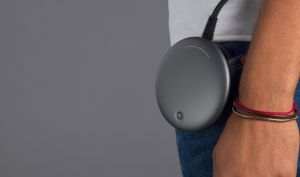
The Lightwear headset features a distinctive design inspired by steampunk aesthetics. The headset includes:
- A six-layer waveguide display system (two layers each for red, green, and blue)[4]
- Resolution of 1280×960 per eye[5]
- Refresh rate of approximately 120 Hz[5]
- Field of view of 40° horizontal, 30° vertical, and 50° diagonal[6]
- Multiple integrated sensors and six external cameras for spatial tracking
- Built-in spatial audio speakers
- Four integrated microphones
- Eye tracking capabilities
The headset was offered in two sizes, with the option for custom temple, nose, and forehead pads. Magic Leap also developed prescription lens inserts for users who required vision correction.[7]
Display Technology
The Magic Leap One uses what the company initially called "Digital Lightfield Technology" but is actually a waveguide-based display system. The display functions by:
1. Using LEDs to generate the light source 2. Directing light onto a liquid crystal on silicon (LCoS) display 3. Reflecting the light to project a virtual image 4. Sending the image through the six-layer waveguide system that directs the image into the user's eyes[8]
The system features two focal planes for managing vergence-accommodation conflict, though the implementation received mixed reviews.[9] The headset blocks approximately 85% of real-world light, which was a point of criticism for some reviewers.[9]
The Lightpack Computer
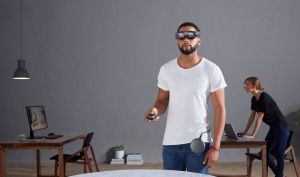
The Lightpack is a disc-shaped computing unit that powers the Magic Leap One system. It features:
- NVIDIA Parker SOC with:
* 2 Denver 2.0 64-bit cores + 4 ARM Cortex A57 64-bit cores (with 2 A57's and 1 Denver accessible to applications) * NVIDIA Pascal GPU with 256 CUDA cores[10]
- 8 GB RAM[5]
- 128 GB storage (with 95 GB available to users)[10]
- Built-in rechargeable lithium-ion battery with up to 3 hours of continuous use[10]
- Bluetooth 4.2, WiFi 802.11ac/b/g/n, and USB-C connectivity[10]
The Lightpack is designed to be clipped to a belt or shoulder pad and is tethered to the headset. This design choice distributed the weight and heat generation away from the user's head, allowing for a more comfortable experience compared to headsets that contain all components in the headgear.[4]
The Controller

The Magic Leap One controller enables interaction with the mixed reality environment. It features:
- 6 degrees of freedom (6DoF) tracking
- 8-bit resolution trigger button
- Digital bumper button
- Digital home button
- Haptic feedback
- Built-in rechargeable lithium-ion battery with up to 7.5 hours of continuous use[10]
The controller uses a combination of electromagnetic tracking and internal sensors to determine its position in 3D space, allowing users to point at and interact with virtual objects.[11]
Technology
Digital Lightfield Technology
Magic Leap's "Digital Lightfield Technology" was one of the company's most promoted features. The technology is based on the theory that the visual cortex in the brain doesn't need all the information-rich light that bounces off objects in the environment. Instead, the device captures select pieces of the light field and delivers them to the brain via the eye.
In practice, the Magic Leap One doesn't use a true lightfield display but rather a waveguide-based system with multiple focal planes to create the illusion of depth.[12] The system projects virtual objects at different depths and blends them with natural light to create digital content that appears to exist in the physical world.
Visual Perception
The Magic Leap One includes a suite of sensors that detect objects, planes, and surfaces in the surrounding environment. This technology enables the system to:
- Create a digital replica of the physical space
- Allow virtual objects to interact with the physical world
- Understand the user's position within the environment
- Enable persistent placement of virtual objects in the real world
Persistent Objects
Through room-mapping and visual perception technologies, the Magic Leap One can store a digital representation of the physical environment. This allows virtual objects placed in a physical space to remain in their position even after the user leaves and returns to the area.
Soundfield Audio
The Magic Leap One features a spatial audio system that adds intensity and distance to sound, creating a more immersive audio experience that matches the visual elements. The built-in speakers deliver audio without requiring headphones, allowing users to maintain awareness of their physical surroundings.
Multiple Input Methods
The Magic Leap One accepts several input methods:
- The handheld controller for pointing and selection
- Eye tracking for gaze-based interaction
- Head position for orientation
- Gesture recognition for hand-based controls
- Voice commands for hands-free operation
Software and Development
Magic Leap developed its own operating system for the Magic Leap One, based on Linux. The company released a Software Development Kit (SDK) alongside the hardware to allow developers to create applications for the platform.
The Magic Leap World store serves as the distribution platform for applications developed for the device. The Creator Portal provides developers with resources, tools, documentation, and sample code to assist in content creation.
LuminOS
LuminOS is the operating system that powers the Magic Leap One. It features:
- A spatial computing environment
- Support for 3D applications and content
- Integration with the device's sensor suite
- APIs for developers to access the hardware capabilities
Magic Kit
Magic Kit is the development framework that includes:
- Unity and Unreal Engine integration
- APIs for spatial mapping
- Tools for creating and manipulating digital content
- Libraries for gesture recognition and voice commands
Applications
The Magic Leap One was positioned for several use cases:
- Entertainment and gaming - bringing characters and interactive elements into the real world
- Communication - enabling more immersive remote collaboration
- Creative work - 3D modeling, design, and artistic expression
- Education - interactive learning experiences
- Productivity - virtual screens and workspaces
Reception
The Magic Leap One received mixed reviews upon its release. While many praised the ambitious nature of the technology and the potential it represented, critics pointed out several limitations:
- The field of view (40° horizontal, 30° vertical) was limited compared to expectations[6]
- The display quality and resolution were considered underwhelming by some reviewers[9]
- The high price point ($2,295) restricted its accessibility[2]
- The waveguide display system significantly darkened the real world environment[9]
- Limited battery life of approximately 3 hours[10]
Despite these criticisms, the Magic Leap One was acknowledged as an important step in the evolution of mixed reality hardware, providing developers with tools to explore the potential of spatial computing.
Legacy and Successor
The Magic Leap One was succeeded by the Magic Leap 2, which was announced in 2021 and released in 2022. The Magic Leap 2 featured several improvements over the original, including:
- Significantly larger field of view (up to 70° diagonal)
- Lighter weight design
- AMD processor platform
- Enterprise-focused applications
As of December 31, 2024, the Magic Leap One reached its end-of-life, with cloud services and support being discontinued.[13]
Pictures
-
The Magic Leap One Lightwear headset
-
The Magic Leap One Lightpack computing unit
-
The Magic Leap One controller
-
Full Magic Leap One system
References
- ↑ "Magic Leap finally unveils augmented reality goggles, says they'll ship in 2018". December 20, 2017. https://www.theverge.com/2017/12/20/16800474/magic-leap-one-creator-edition-augmented-reality-goggles-announce.
- ↑ 2.0 2.1 "Magic Leap One: Creator's Edition now available to buy in US". August 8, 2018. https://www.trustedreviews.com/news/magic-leap-one-release-date-3359749.
- ↑ 3.0 3.1 "Magic Leap - Wikipedia". https://en.wikipedia.org/wiki/Magic_Leap. Retrieved May 5, 2025.
- ↑ 4.0 4.1 "Magic Leap 1 augmented reality headset: A cheat sheet". March 25, 2020. https://www.techrepublic.com/article/magic-leap-1-augmented-reality-headset-a-cheat-sheet/.
- ↑ 5.0 5.1 5.2 "Magic Leap 1: Full Specification". https://vr-compare.com/headset/magicleap1. Retrieved May 5, 2025.
- ↑ 6.0 6.1 "Magic Leap One Field of View Specs Finally Uncovered". July 31, 2018. https://magic-leap.reality.news/news/magic-leap-one-field-view-specs-finally-uncovered-0186278/.
- ↑ "Magic Leap One - Review - Full specification". https://www.niora.net/en/p/magic_leap_one. Retrieved May 5, 2025.
- ↑ "Tearing Down a Magic Leap One Mixed Reality Headset Is Magical in Its Own Way". October 2, 2018. https://www.solidsmack.com/engineering/tearing-down-a-magic-leap-one-mixed-reality-headset-is-magical-in-its-own-way/.
- ↑ 9.0 9.1 9.2 9.3 "Magic Leap Review Part 1 – The Terrible View Through Diffraction Gratings". September 26, 2018. https://kguttag.com/2018/09/26/magic-leap-review-part-1-the-terrible-view-through-diffraction-gratings/.
- ↑ 10.0 10.1 10.2 10.3 10.4 10.5 "Specs - Magic Leap One: Creator's Edition". https://magic-leap.fandom.com/wiki/Specs_-_Magic_Leap_One:_Creator's_Edition. Retrieved May 5, 2025.
- ↑ "Here's a good explanation on how the $2,295 Magic Leap One headset works". August 24, 2018. https://www.cnbc.com/2018/08/24/how-magic-leap-works-ifixit-teardown.html.
- ↑ "Teardown of Magic Leap One reveals highly advanced placeholder tech". August 23, 2018. https://techcrunch.com/2018/08/23/teardown-of-magic-leap-one-reveals-highly-advanced-placeholder-tech/.
- ↑ "Magic Leap 1 End of Life". https://www.magicleap.care/hc/en-us/articles/18878883445645-Magic-Leap-1-End-of-Life. Retrieved May 5, 2025.



